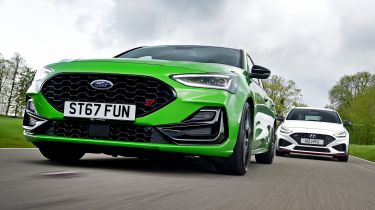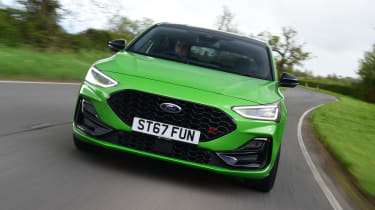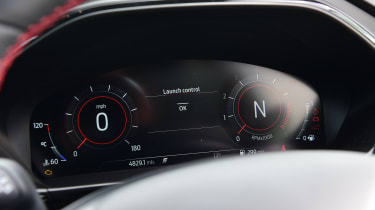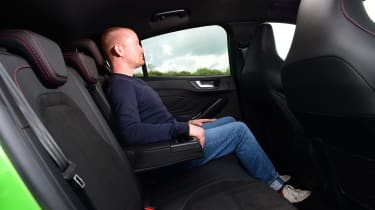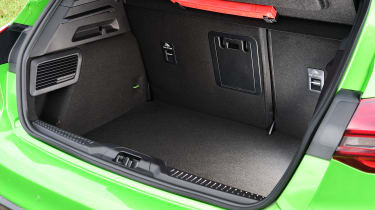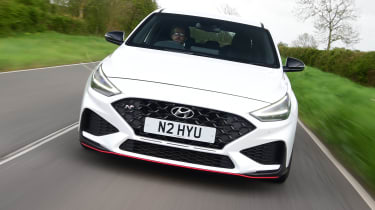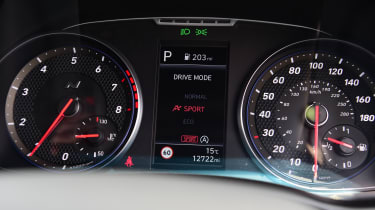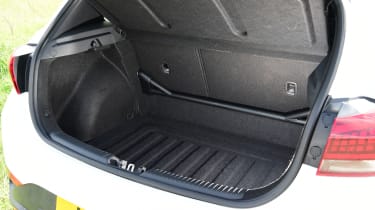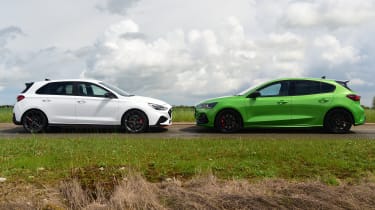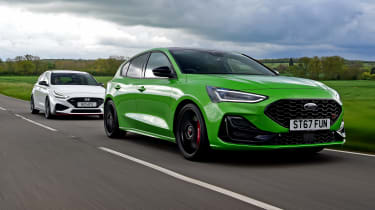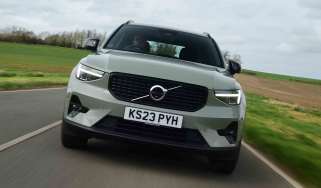Ford Focus ST Track Pack vs Hyundai i30 N: 2023 twin test review
The Track Pack version of the Focus is the latest fast Ford. We put it through its paces against Hyundai’s i30 N hot hatch
The Track Pack version of the Focus is the latest fast Ford. We put it through its paces against Hyundai’s i30 N hot hatch
The Honda Civic Type R is a phenomenal hot hatch. However, with the latest version coming in at a hefty £49,090, it’s not exactly the working-class hero that it used to be.
So, the title of the top attainable hot hatch falls to others. A fast Ford has been the go-to blue-collar performance icon for decades, and now Ford reckons it’s made one of its best even better with the Focus ST Track Pack.
To see how good it is, we’ve brought along one of our favourite alternatives. Hyundai’s N division hasn’t missed a beat since it burst onto the scene with the i30 N, and we’re revisiting that car here because the Korean model has a lot of talent for the Focus to overcome. Our in-depth real-world review will reveal the winner.
| Ford Focus ST Track Pack | Hyundai i30 N Performance | |
| Price: | £39,950 | £35,110 |
| Powertrain: | 2.3-litre 4cyl turbo, 276bhp, six-speed manual | 2.0-litre 4cyl turbo, 276bhp, six-speed manual |
| 0-62mph: | 5.7 seconds | 5.9 seconds |
| Efficiency: | 32.1mpg/7.1mpl | 28.8mpg/6.3mpl |
| CO2: | 185g/km | 182g/km |
| Annual VED: | £180 | £180 |
Ford Focus ST Track Pack
Buyers can get behind the wheel of the Focus ST from £36,950, but we’re keen to find out whether the Track Pack, which is available as a £3,000 option, is worthwhile. The Mean Green paint of our test car costs another £825, which brings its total cost to £40,775.
Tech highlights
We’re well acquainted with the fourth-generation Focus ST, and it’s not a car that we’ve ever felt was lacking in terms of sharpness. That hasn’t stopped Ford from trying to improve things, though, and the result is this Track Pack.
Used - available now

2023 ISUZU
D-MAX
38,628 milesManualDiesel1.9L
Cash £22,793
2023 ISUZU
D-MAX
33,508 milesManualDiesel1.9L
Cash £21,593
2023 TOYOTA
HILUX
8,729 milesManualDiesel2.4L
Cash £28,793
2023 TOYOTA
HILUX
22,324 milesAutomaticDiesel2.8L
Cash £36,994The upgrades look to improve the response of the chassis, so the pack adds a set of KW adjustable coilovers all round. There are 12 levels of adjustment, while the springs are up to 50 per cent stiffer and 25mm lower than the standard ST’s. New 19-inch wheels reduce unsprung mass by 10 per cent over the stock model, and behind them are a set of 363mm (up from 330mm) Brembo brake discs at the front that are gripped by red calipers. A Track Mode is also added to the drive settings.
This introduces a launch-control system and shift lights for the six-speed manual transmission. The remaining changes are cosmetic; those wheels are painted in gloss black, as are the grille, rear spoiler, diffuser and door mirrors.
The powertrain is unchanged from the standard ST, so power comes from a 2.3-litre turbocharged four-cylinder petrol engine that develops 276bhp and 420Nm of torque. This is sent through the front wheels via an electronically controlled limited-slip differential.
Safety: The Focus was tested by Euro NCAP in 2018, and scored a full five-star rating. Some assistance features are options; the £550 Driver Assist Pack adds traffic-sign recognition, for example.
On the road
It doesn’t take long to confirm that the Track Pack adds a new level of sophistication to the way that the Focus ST drives. The fact it manages to keep the regular car’s slightly lairy personality is a bonus.
Around town: It’s a given that modern hot hatchbacks feel quite firm at low speeds, but the Track Pack’s higher-quality KW suspension and reduced unsprung weight have enabled it to round off the harshest bumps in a way that the standard Focus ST cannot.
A & B-roads: Increase your pace and you can really feel the benefits of that uprated suspension. Body control is superb; the Track Pack manages to flow across B-roads in a way that suggests it was designed just for the UK. The steering is quick – almost too quick – but once you dial into its response, it manages to match up to the ST’s incredibly agile chassis.
Combined with the grip from those Pirelli tyres, there are very few cars that would be able to keep pace with the Track Pack along a difficult stretch of tarmac. Yet this uprated Focus offers all of this speed while still maintaining the playful, slightly boisterous feel of the standard ST.
Lift off the throttle mid-corner and the Focus will tighten its line gamely; do it too aggressively and you’ll need to wind off the lock to correct the rear end swinging around.
And if you want to alter the Track Pack’s balance – or relax the ride quality – then you can manually adjust the damping rates to get them how you like.
Motorway: The stability is hard to fault, with that suspension working just as well at high speeds as it does on twisty asphalt. These rivals both suffer from noticeable road noise, thanks to their wide tyres.
Ownership
As with the rest of the Focus line-up, the ST’s cabin gained a big upgrade when the range was facelifted in 2022. This introduced a revised dashboard layout with a huge touchscreen infotainment system and a digital instrument panel. Build quality is fine, feeling a little better than the Hyundai in terms of soft-touch surfaces.
Previous Focus STs used Recaro sports seats up front, but in this latest variant they’re designed by Ford Performance. While there’s plenty of adjustment in the steering wheel and the seats themselves, some testers found the upper side bolsters – especially around the shoulders – a little too restrictive. Red stitching on the seats, plus the steering wheel and the gearlever gaiter, lift an otherwise black and murky interior.
Flicking through the various drive modes is fairly easy, because Ford has mounted the buttons on the steering wheel; one of these switches the car directly into Sport mode. The buttons are quite small and fiddly to operate, though.
Ford’s warranty package runs to three years and 60,000 miles. While this was once the standard among most new cars, many manufacturers – including Hyundai – now offer more generous packages. Also included from new is a UK and European roadside assistance package that runs for one year. If you service your Focus ST at a participating Ford dealer, that breakdown cover is extended for a further 12 months.
Storage: The ST gets all of the usual storage points you’ll find in a regular Focus. That means those up front get a covered compartment with a couple of cup-holders, a decent-sized glovebox and a shelf in the centre console that’ll hold a smartphone (it also contains two USB ports for charging). The door bins in the front are fairly roomy, although the bins in the back are only really suitable for drinks bottles.
Practicality
Part of the appeal of a hot hatchback is that it’s both exciting and practical enough to use every day. The Focus manages to score well when it comes to both passenger and storage space.
Rear Space: One of the Focus’s strong points is rear kneeroom, which is among the best of the compact hatchbacks. However, headroom is a little below the best that the segment has to offer. The middle seat is fine for short trips, but its perched position only emphasises the low roof. Those in the back get a pair of USB-C sockets to keep their devices charged up.
Boot: The 443-litre boot capacity is generous, and the 665mm lip height is quite low, so it’s easy to load heavy items into the space. The 60:40 boot split has a ski hatch for loading long items, and when folded, they drop almost flat, and expand the total volume to 1,454 litres.
What to buy?
Which engine and trim we’d choose
- Engines: Ford’s 2.3-litre turbocharged EcoBoost engine is the only option available with the ST Track Pack. Unlike the standard ST, which can be had with an eight-speed automatic gearbox, the Track Pack is a six-speed manual only.
- Trim: While earlier STs came in various specification levels, the latest model is only offered in a single ST trim.
- Options: In addition to the Driver Assist Pack, there’s blind-spot detection (£450) and a Parking Pack with active park assist and door-edge protectors (£300).
A panoramic sunroof is £1,045 extra. - Our choice: If you can stretch to the Track Pack, we strongly recommend that you do.
Hyundai i30 N
The i30 N in these pictures uses a dual-clutch automatic gearbox, although the car we’re testing against the Focus is the six-speed manual version. Starting from £35,110, it’s cheaper than the Focus to buy outright, and the only extra fitted to our car is the £300 Polar White paint.
Tech highlights
With a 2.0-litre turbo petrol compared with the Ford’s 2.3, you might expect the i30 N to fall short of its rival, but the Korean contender produces the exact same peak of 276bhp. It does offer less torque – at 392Nm, it’s 28Nm behind – but that maximum is available all the way from 2,100-4,700rpm. As in the Focus, a sound generator amplifies the car’s engine note inside the cabin.
When the i30 N was updated in 2021, Hyundai’s engineers turned their attention to the model’s suspension. They increased negative camber to 1.5 degrees, and introduced revised springs, bump stops and dampers. Unlike with the Focus, those dampers are remotely adjustable adaptive units that allow the driver to choose from one of three settings on the touchscreen infotainment system.
The stability control also comes in three stages. The standard set-up delivers safe, controlled handling, ESP Sport allows for some slip angle before gathering things up, or it can be fully disabled when driving on track. You can either alter these settings independently using the Custom mode, or choose from the preset Eco, Normal, Sport or N options.
Safety: A five-star rating was awarded to the i30 when it was tested by Euro NCAP back in 2017. While its rating was enough for the top score, its individual category marks were all a few per cent lower than the Focus, which was tested by the safety-assessment programme one year later.
On the road
There’s no denying that Hyundai has produced a thrilling hatchback with the i30 N. But while it just pips the Ford in one or two areas, the Korean model falls slightly short in a few others.
Around town: The basic controls of the i30 N are better weighted than in the Ford. This means that steering at low speeds, or just gently working your way through the manual gearbox, is a more pleasurable experience all of the time. The only slight drawback is a level of rev hang from the engine as you come off the throttle; it makes smooth gearchanges a little trickier.
A & B-roads: While drivers are offered three damper settings, we found that we left the i30 N in its most forgiving mode all the time. The next step up in response is too firm on all but the smoothest A-roads, while the final setting will be too harsh anywhere other than on an F1-grade racetrack.
That’s not too much of a problem, because the standard set-up still offers excellent body control and minimal roll. That well weighted steering works at higher speeds, too, giving you plenty of confidence to push on. When you do, you’ll discover that the front end isn’t quite as positive as the ST’s, and the rear end feels more planted.
While some will prefer this added security, we found that it made the i30 N less adjustable and less exciting to drive. This is all relative, though; the Hyundai is still fantastic through the turns.
Motorway: At a cruise, the Hyundai’s less sophisticated dampers can’t deal with bumps quite as adeptly as the Ford’s KW coilovers can. The result is just a little more fidget, even at high speeds. The loud exhaust note settles down, though, so ride aside, it’s fairly relaxing over long distances
Ownership
Hyundai’s signature pale Performance Blue colour features in a few key areas inside the N. The stitching to the seats, plus a highlight on the round, stubby gearlever are there if you look closely, but the most significant addition comes in the shape of two extra buttons mounted on the underside of the steering wheel spokes.
The left button lets you switch through each of the drive modes, while the right one offers the choice of two preset ‘N’ modes. In each of these, the driver is able to pre-select parameters such as the engine and transmission sensitivity, the response of the electronic differential and stability control, the damping and steering rates, plus the noise level from the exhaust. These can be pre-set in advance through the main touchscreen. The overall dash design is a little plain, and there are a few more hard plastics to be found than in the ST, especially around the centre console. The driving position is excellent, with lots of adjustment.
Hyundai provides a five-year warranty as standard across its range. Also included is 12 months’ breakdown cover. Hopefully you won’t need it, but 21.3 per cent of Hyundai owners experienced some sort of fault with their car, according to our 2022 Driver Power survey, which is slightly more than the 21.18 per cent of Ford owners who found an issue.
Storage: The i30 gets a large glovebox, but it’s needed to house the enormous owner’s manual. Elsewhere, storage is hit and miss. The front bin is a little tight for a modern smartphone, but there’s also a reasonably deep cubby under the central armrest. The door bins front and rear securely hold drinks bottles. The centre console has two cup-holders, beside which sits a manual handbrake. This takes up more space than the ST’s electronic parking brake, but keen drivers will probably welcome the decision to stick with a physical lever.
Practicality
The Hyundai i30 N comes with fewer concessions to practicality than its rival, but overall it’s still spacious enough.
Rear Space: While most adults will have no complaints in the back of the i30 N, its kneeroom is no match for the Ford’s. However, both elbow and headroom are very slightly better in the Hyundai.
Boot: One of the slight compromises that you need to consider with the i30 N comes right in the back. Extra chassis strengthening, in the form of a large brace that runs between the rear strut towers, and across the boot area, takes up a little storage space. It’s up against the seat backs and roughly at the height of the seat bases when they’re folded flat.
While larger items such as bikes can still fit inside, the shape of the brace makes getting them in slightly more awkward than in the Focus.
What to buy?
Which engine and trim we’d choose
- Engines: Under the bonnet sits the most potent version of Hyundai’s 2.0-litre ‘Theta II’ four-cylinder turbocharged engine. A six-speed manual gearbox is standard, while the eight-speed dual clutch automatic is a £2,025 option.
- Trim: In some markets, Hyundai offers a less potent version of the i30 N, but in the UK we only get the top-spec Performance trim.
- Options: The only ways to personalise your i30 N are through a set of N Light Sports Bucket seats and the various exterior paint colours.
- Our choice: What you see is pretty much what you get with the i30 N.
Results
Which car comes out on top?
Winner: Ford Focus ST Track Pack
Both of these hot hatches score strongly for thrills, but the Focus takes the win because it offers just a little bit more; it’s sharper, more sophisticated and slightly faster.
While it also costs a little more for a cash buyer, it’s also cheaper than the i30 N on monthly payments, while slightly undercutting its rival on other running costs. There’s a big boot and plenty of rear-seat space, too. Overall the Track Pack makes this swansong for Ford hot hatches one of its best drives ever.
| Pros | Cons |
| Fantastic poise and grip | Slightly tight headroom |
| Strong performance | Not much performance tech |
| Composed ride | So-so gearshift |
| Generous boot space | Road noise |
Runner up: Hyundai i30 N
In isolation, the i30 N remains a fabulous hot hatchback. It’s keen and thrilling to drive when you’re in the mood, yet when you’re not, it’s easy enough to live with every day. It always feels like an event to drive – even slowly – yet easily caters for a family, and has slick in-car tech.
However, in the areas which matter most to a keen driver, it usually plays second best to the Ford – if only just at times. Factor in its higher running costs and it has to settle for second place here.
| Pros | Cons |
| Keen chassis | A little thirsty |
| Sweet steering and gearshift | Exhaust note is an acquired taste |
| Slick infotainment | Plain dashboard design |
| Strong kit levels | Higher running costs |
Rivals and other options
- Same class: Honda Civic Type R
- Same money: Volkswagen Golf GTI Clubsport
- Used: Audi RS3 Sportback
- Used: BMW M340i xDrive
- Coming soon: Alpine A290
The great debate
What the Auto Express test team would do…
Sean Carson, associate editor: “If you’re happy to give up a little room, then the Toyota GR Yaris is still well worth a look. It trades any sort of reasonable rear space for a four-wheel drive system and a 257bhp three-cylinder engine, which combine with a short wheelbase to deliver incredible B-road pace.”
John McIlroy, deputy editor: “In previous Focus generations, the ST model sat below an RS performance flagship. Ford chose not to go that route this time. But if you want more speed, you can turn to Mountune. We’ve driven its M365; with 360bhp going through the front wheels, it makes for a very lively driving experience.”
Dawn Grant, picture editor: “Both of these cars sit in the top 37-per-cent Benefit-in-Kind bracket, so they’re pricey for company car users, but Vauxhall offers an answer with the Astra GSe. Plug-in tech keeps emissions low, yet it makes 222bhp. You’ll need to sacrifice some fun for the lower running costs, though.”
Steve Fowler, editor-in-chief: “Fast Fords were once the standard bearer for affordable performance cars. But with the demise of the Fiesta, Ford’s most affordable option, the Fiesta ST, will disappear. The Puma ST is fun, but with that and a £40k Focus, we wonder where the attainable fast cars will come from next.”
Dean Gibson, senior test editor: “Hyundai’s N division grows larger. The i30 N was followed by the i20 N and Kona N, and next it will turn its attention to the electric Ioniq 5. The 5’s spectacular styling is sure to turn heads, as will the promise of somewhere in the region of 570bhp and 740Nm of torque.”
What would you do? Let us know in the comments section below…
Specs and prices
| Ford Focus ST 2.3L EcoBoost Track Pack | Hyundai i30 N 2.0 T-GDi Performance | |
| Petrol or diesel? | Petrol | Petrol |
| MPG | 32.1 | 28.8 |
| Fuel price (£) | £1.44 | £1.44 |
| P11D value | £38,855 | £34,015 |
| Fill up | £75.08 | £72.20 |
| On the road price/total as tested | £39,950 / £40,775 | £35,110 / £35,410 |
| Residual value (after 3yrs/36,000) | £19,951 (49.94%) | £18,724 (53.33%) |
| Depreciation | £19,999 | £16,386 |
| Annual tax liability std/higher rate | £2,875.27 / £5,750.50 | £2,517.11 / £5,034.20 |
| Annual fuel cost (10k/20k miles) | £2,045 (£4,090) | £2,279 (£4,559) |
| Ins. group/quote/VED | 34/£686/£180 | 26/£893/£180 |
| Service costs (3 years) | £574 | £674 |
| Length/wheelbase | 4,378/2,700mm | 4,340,2,650mm |
| Height/width | 1,471/1,848mm | 1,445/1,795mm |
| Engine | 4cyl in turbo/2,261cc | 4cyl in turbo/1,998cc |
| Peak power/revs | 276/5,500bhp/rpm | 276/5,500-6,000bhp/rpm |
| Peak torque/revs | 420/3,000-4,000Nm/rpm | 392/2,100-4,700Nm/rpm |
| Transmission | Six-speed man/fwd | Six-speed man/fwd |
| Fuel tank capacity/spare wheel | 52 litres / repair kit | 50 litres / repair kit |
| Boot capacity (seats up/down) | 443/1,454 litres | 381/1,287 litres |
| Kerbweight | 1,432/1,100kg | 1,419/1,600kg |
| Turning circle | 10.7 metres | 10.7 metres |
| Basic warranty/recovery | 3yrs (60,000)/1yr | 5 yrs (unlimited)/1 yr |
| Driver Power manufacturer position | 25th | 11th |
| Euro NCAP: Adult/child/ped./assist/stars | 96/87/72/75/5 (2018) | 88/84/64/68/5 (2017) |
| 0-62mph/top speed | 5.7 seconds/155mph | 5.9 seconds/155mph |
| Auto Express economy/range | 32.1/367 | 28.8/317 |
| WLTP combined | 34.9mpg | 35.3mpg |
| WLTP combined | 7.7mpl | 7.8mpl |
| Actual/claimed CO2 | 203 / 185g/km | 227 / 182g/km |
| Number of airbags/Isofix points | Six/two | Six/two |
| Parking sensors/camera | F&r/yes | F&r/yes |
| Lane-keep assist/blindspot/AEB | Yes/£450/yes | Yes/no/yes |
| Climate control/adaptive cruise | Two-zone/£550* (*Part of Driver Assist Pack) | Two-zone/no |
| Leather/heated seats/wheel | Part/yes/yes | Part/yes/yes |
| Metallic paint/LED lights | £575/yes | £585/yes |
| Keyless entry & go/powered tailgate | Yes/no | Yes/no |
| Sat-nav/digital dashboard/USBs | Yes/yes/four | Yes/no/three |
| Online services/wireless charging | Yes/yes | Yes/yes |
| Apple CarPlay/Android Auto | Yes/yes | Yes/yes |

